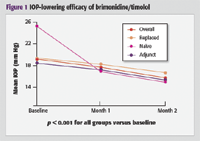Drug combo may manage intraocular pressure in glaucoma patients
A particular fixed-combination ophthalmic solution for glaucoma effectively controls IOP and potentially may increase patient adherence to therapy, an issue commonly associated with multi-drug regimens for the disease.

Key Points

"It is not uncommon that, over the course of 3 to 5 years, many [patients with glaucoma] will require more than one IOP-lowering agent to . . . manage and control their IOP [adequately]," said Ronald Fellman, MD, of Glaucoma Associates of Texas, Dallas. "The use of several different pressure-lowering agents can often lead to issues of compliance as well as an increased risk of ocular irritation. Fixed-combination drugs could potentially offer a solution to these problems."
He reported the results of a study of one such drug, brimonidine tartrate 0.2%/timolol maleate 0.5% (Combigan, Allergan), that sought to evaluate in a clinical setting its efficacy, safety, and tolerability/comfort level.
Participants were evaluated at baseline and at 1 month and 2 months. Eighty percent of patients completed the study.
Outcome measures
The primary outcome measure was mean IOP. Secondary outcome measures were change from baseline IOP, patient and physician satisfaction, and adverse events. IOP data were evaluated by measuring one eye from each patient. If the study medication was used in both of a patient's eyes, then the eye with the higher IOP at baseline was used; if IOP in both eyes was equal at baseline, then IOP in the right eye was measured on the subsequent visits.
At the 1-month and 2-month study visits, all patients had a lower IOP compared with IOP at baseline. Significantly more patients (76%) reached their target IOP using brimonidine/timolol either as a single agent or adjunct therapy than did before beginning brimonidine/timolol therapy (40.5%). Also, 96.5% of patients reported a favorable acceptability and tolerability for brimonidine/timolol, and 55.3% rated the drug as better than medications they previously had used.
Physicians reported that, compared with baseline, an improvement in both IOP-lowering efficacy and tolerability could be achieved with brimonidine/timolol, even in patients whose IOP previously was considered difficult to control.
"Using fixed-combination drugs in [patients with glaucoma] can make it much easier for the patients to comply to therapy for several reasons," he said. "Patients may only need to worry about applying a single-drop medication, which will likely lead to a much higher compliance.
"Also, if the load of potential irritants and/or preservatives to the eye is decreased, the potential for ocular irritation is decreased as well, again leading to a better compliance and better IOP control results," Dr. Fellman added.
Adverse events each occurring in 2.5% or less of study patients included hyperemia, burning, oral dryness, and blurred vision, which, according to Dr. Fellman, is not uncommon with glaucoma medications. The study found that 25% fewer patients reported experiencing symptoms of stinging and burning with brimonidine/timolol compared with the glaucoma regimen they used before the study. Decreases also were found related to eye redness and blurred vision. Unlike controlled studies, this one was performed in a clinical setting, which may best mimic the real world, Dr. Fellman said.
In this study, patient IOP was measured at various times during the day and throughout the study. This practice certainly mimics daily life in the glaucoma clinic, he added.

"Having a patient [take] a drug that inhibits aqueous production along with a drug that enhances outflow can significantly help in reducing IOP and keeping it at a desired level," he said.
Another FDA-approved fixed-combination drug available for glaucoma in the United States is dorzolamide hydrochloride/timolol maleate ophthalmic solution (Cosopt, Merck), he said, which reportedly has an efficacy similar to brimonidine/timolol in reducing and stabilizing IOP.
Dorzolamide/timolol also contains a beta blocker, but instead of being combined with an alpha-2 adrenergic receptor agonist (brimonidine), it is combined with a carbonic anhydrase inhibitor (dorzolamide), he said.
Newsletter
Want more insights like this? Subscribe to Optometry Times and get clinical pearls and practice tips delivered straight to your inbox.